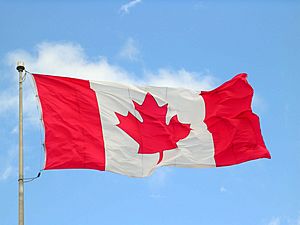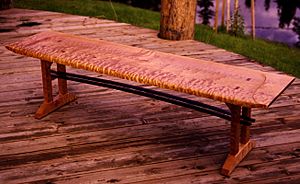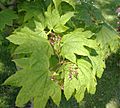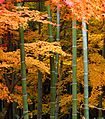Maple facts for kids
Quick facts for kids Maple |
|
|---|---|
 |
|
| Acer pseudoplatanus (Sycamore Maple) foliage | |
| Scientific classification | |
| Kingdom: | |
| Division: | |
| Class: | |
| Order: | |
| Family: | |
| Genus: |
Acer
|
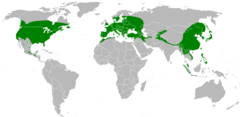 |
|
| Distribution | |
Maples are a type of tree or shrub. They belong to a group of plants called the Acer genus. Scientists now usually place them in the Sapindaceae family. There are between 100 and 200 different kinds, or species, of maples. Most maples come from Asia. You can also find them in Europe, Northern Africa, and North America.
The name Acer comes from a Latin word meaning "sharp." This name was chosen because maple leaves often have sharp points. The Acer pseudoplatanus, also known as the Sycamore Maple, is a well-known type of maple.
Contents
How Maple Seeds Travel
Maple trees have special fruits called samaras. Many kids know them as "helicopters" because of how they spin. Inside these fruits are the maple seeds, usually in pairs. Each seed is in a small "nutlet" with a flat, papery wing. These wings help the seeds spin as they fall. This spinning lets the wind carry the seeds far away from the parent tree.
One maple tree can release hundreds of thousands of seeds at once. Some of these seeds can stay in the soil for several years. They wait there until the conditions are just right to start growing.
What Are Maples Used For?
Growing Maples in Gardens

Many people plant maples in their gardens and parks. They are popular because of their beautiful colors in the fall. Maples also grow fairly quickly and are easy to move. Plus, their seeds are not hard, so they don't cause problems when mowing lawns.
Some popular types include the Norway maple, silver maple, Japanese maple, and red maple. Smaller or more unusual maples are also liked as special trees in gardens.
Special Maple Varieties
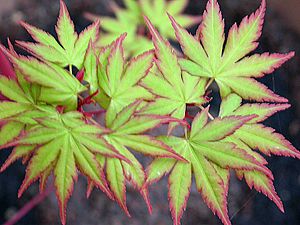
There are many special types of maples, called cultivars. These are chosen for unique features. They can only be grown from parts of the parent plant, like cuttings. For example, the Acer palmatum (Japanese maple) has over 1,000 different cultivars. Most of these were first grown in Japan. Some very delicate types are often grown in pots. They usually stay small, less than a meter tall.
Bonsai Art
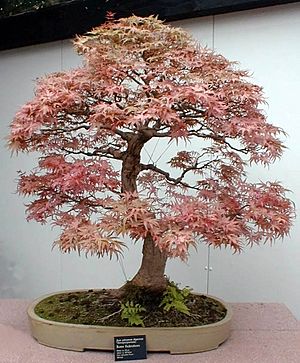
Maples are a favorite for the art of bonsai. Bonsai is about growing small trees in pots. The Japanese maple, trident maple, and field maple are good choices. They respond well to shaping techniques. These techniques help make the leaves smaller and the branches grow in a detailed way.
Maple Leaf Tourism
Many maples have bright, colorful leaves in the autumn. This makes them a big attraction for tourists. In Japan, people have a tradition called "momijigari." This means viewing the changing colors of maple leaves in the fall. Places like Nikko and Kyoto are famous for this activity. In Korea, this tradition is called "Danpung-Nori." The Seoraksan and Naejang-san mountains are popular spots.
In North America, the sugar maple helps bring in many visitors. This is especially true in parts of Canada and the northern United States. People travel to see the amazing fall colors.
Commercial Uses of Maples
Maples are important for making syrup and wood. Their dried wood is often used for smoking food. Maple charcoal is also used to make Tennessee whiskey. Maples are also grown as ornamental plants. They also help with tourism and agriculture.
Maple Syrup
The sugar maple (A. saccharum) is famous for its sap. This sap is collected and then boiled down. It turns into delicious maple syrup, maple sugar, or maple taffy. It takes about 40 liters (10.5 gallons) of sap to make just 1 liter (1 quart) of syrup. While you can tap any maple for sap, most don't have enough sugar to be useful for making syrup to sell.
Maple Wood
Some larger maple species provide valuable timber. This includes the Sugar maple in North America and the Sycamore maple in Europe. Sugar maple wood is very hard. It is used for bowling pins, bowling alley floors, and butcher's blocks. Maple wood is also used for baseball bats. It was first used in Major League Baseball in 1998.
Maple wood is also used in archery. It is a strong and stiff material for recurve bows. Some maple wood has beautiful patterns. These patterns are called flame maple, quilt maple, birdseye maple, and burl wood. These special patterns are found in random trees. They often cannot be seen until the wood is cut. Maples have been used to make furniture in the United States for a long time.
Maple in Music
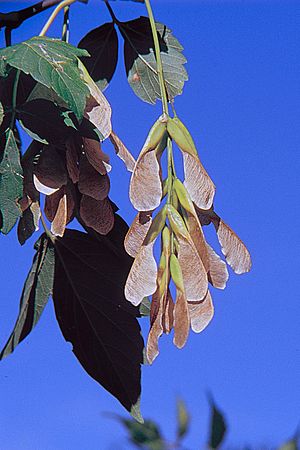
Maple is known as a tonewood. This means it carries sound waves very well. It is used in many musical instruments. Maple wood is harder than mahogany. It also makes a brighter sound.
The back, sides, and neck of most violins, violas, cellos, and double basses are made from maple. Electric guitar necks are often made from maple. This is because maple is very stable. The tops of some Les Paul guitars are also made from carved maple. Maple is also used to make bassoons and other woodwind instruments.
Many drums are made from maple. Maple drum kits were very popular from the 1970s to the 1990s. Drummers like maple drums for their bright and clear sound. Some drumsticks are also made from maple.
Maples and Bees
Maples are a main source of pollen in early spring. This is before many other plants have flowers. So, maples are very important for honeybees. Honeybees play a big role in helping other plants grow later in the year.
Symbolism
The flag of Canada proudly shows a stylized maple leaf.
Images for kids
-
Acer saccharum (sugar maple)
-
Acer circinatum (vine maple) leaves showing the palmate veining typical of most species
-
Acer rubrum (red maple) flowers
-
Acer palmatum (Japanese maple) has over 1,000 cultivars. This cultivar is A. palmatum 'Sango kaku', sometimes called "coralbark maple"
-
Acer × freemanii 'Autumn Blaze' (a cross between A. rubrum and A. saccharinum
-
Acer macrophyllum flowers and young leaves
-
Acer grandidentatum (bigtooth maple) in autumn colour
-
Acer palmatum leaf in autumn
See also
 In Spanish: Arce para niños
In Spanish: Arce para niños


